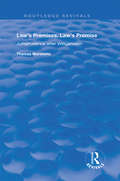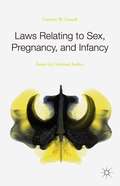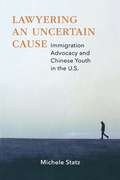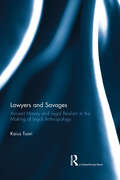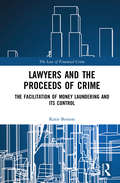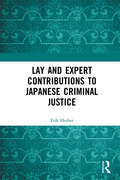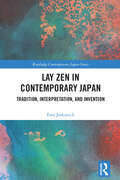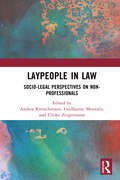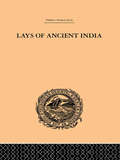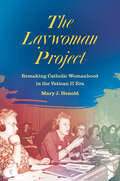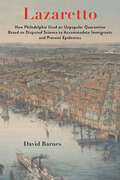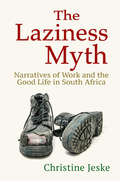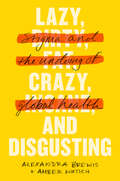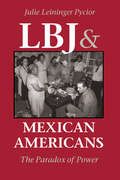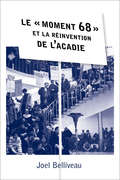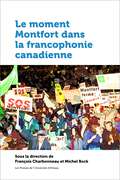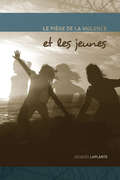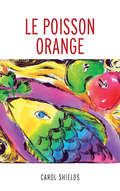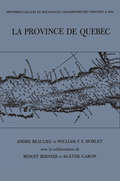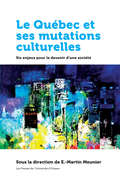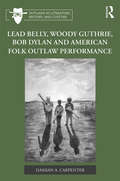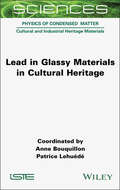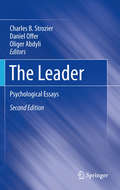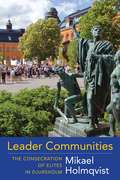- Table View
- List View
Law's Premises, Law's Promise: Jurisprudence After Wittgenstein
by Thomas MorawetzThis title was first published in 2000: The author is a legal and moral philosopher who has applied the insight and methods of Wittgenstein to a range of topics in constitutional law, criminal law and theories of justice. This collection offers his most important and influential essays, together with an introductory essay which reviews and develops his contribution to legal and moral philosophy.
Laws Relating to Sex, Pregnancy, and Infancy
by Carmen M. CusackLaws Relating to Sex, Pregnancy, and Infancy examines case law and legislation in regards to reproduction, pregnancy, and infancy. Cusack explores the winding pathways of legal precedence and action on the social conditions of pregnancy and childbirth, and draws from criminal and court procedures and behavioral science to determine if the law is acting in the best interest of those vulnerable populations. Cusack surveys interpersonal, familial, and societal problems presented throughout history and currently facing contemporary generations, questioning whether the criminal justice system can evolve to support the growing needs of its citizens most in need of legal assistance.
Lawyering an Uncertain Cause: Immigration Advocacy and Chinese Youth in the US
by Michele StatzEach year, a number of youth who migrate alone and clandestinely from China to the United States are apprehended, placed in removal proceedings, and designated as unaccompanied minors. These young migrants represent only a fraction of all unaccompanied minors in the US, yet they are in many ways depicted as a preeminent professional and moral cause by immigration advocates.In and beyond the legal realm, the figure of the "vulnerable Chinese child" powerfully legitimates legal claims and attorneys' efforts. At the same time, the transnational ambitions and obligations of Chinese youth implicitly unsettle this figure. Youths' maneuvers not only belie attorneys' reliance on racialized discourses of childhood and the Chinese family, but they also reveal more broad uncertainties around legal frameworks, institutional practices, health and labor rights—and cause lawyering itself.Based on three years of fieldwork across the United States, Lawyering an Uncertain Cause is a novel study of the complex and often contradictory rights, responsibilities, and expectations that motivate global youth and the American attorneys who work on their behalf.
Lawyers and Savages: Ancient History and Legal Realism in the Making of Legal Anthropology
by Kaius TuoriLegal primitivism was a complex phenomenon that combined the study of early European legal traditions with studies of the legal customs of indigenous peoples. Lawyers and Savages: Ancient History and Legal Realism in the Making of Legal Anthropology explores the rise and fall of legal primitivism, and its connection to the colonial encounter. Through examples such as blood feuds, communalism, ordeals, ritual formalism and polygamy, this book traces the intellectual revolution of legal anthropology and demonstrates how this scholarship had a clear impact in legitimating the colonial experience. Detailing how legal realism drew on anthropology in order to help counter the hypothetical constructs of legal formalism, this book also shows how, despite their explicit rejection, the central themes of primitive law continue to influence current ideas – about indigenous legal systems, but also of the place and role of law in development. Written in an engaging style and rich in examples from history and literature, this book will be invaluable to those with interests in legal realism, legal history or legal anthropology.
Lawyers and the Proceeds of Crime: The Facilitation of Money Laundering and its Control (The Law of Financial Crime)
by Katie BensonThe role played by legal professionals in the laundering of criminal proceeds generated by others has become a priority concern for authorities at national and international levels. This ground-breaking book presents an in-depth empirical analysis of the nature of lawyers’ involvement in the facilitation of money laundering and its control through criminal justice and regulatory mechanisms. It is based on qualitative research combining analysis of cases of lawyers convicted of money laundering offences with interviews with criminal justice practitioners, members of professional and regulatory bodies and practising solicitors, and analysis of relevant national and international legislative and regulatory frameworks. The book demonstrates the complex and diverse nature of lawyers’ involvement in laundering activity, and shows that their actions and the decisions they take must be understood in relation to the specific situational contexts in which they occur. It provides significant new insights into the criminal justice and regulatory response to professional facilitation of money laundering in the UK, raising questions about the effectiveness and appropriateness of the response and the challenges involved. The book develops a framework for future research and analysis in this area, and proposes a range of potential strategies for controlling the facilitation of money laundering. Lawyers and the Proceeds of Crime is essential reading for those researching money laundering, white-collar crime or organised crime, and for practitioners and policy makers concerned with preventing the facilitation of money laundering.
Lawyers, Guns, and Money
by Carol X. VinzantThis inspiring book, Lawyers, Guns, and Money by Carol X. Vinzant, recounts the heroic efforts of Tom McDermott, a lawyer and victim of the infamous Colin Ferguson rampage on the Long Island Railroad, to take on the gun industry. He is among the leaders of an innovative and promising strategy to circumvent the NRA's political power and courts constrained by interpretations of the Second Amendment. Through civil action he hits the gun companies where it hurts most: the bottom line. Making insurance difficult for manufacturers to get, he has helped reduce the number of cheap hand guns, "Saturday Night Specials," often used in crime. This is a riveting account of tragedy turned into action, and how the law can be used to defend victims rather than enrich corporations.
Lay and Expert Contributions to Japanese Criminal Justice: Legal Outsiders
by Erik HerberThis book examines the little or not previously researched roles and contributions of non-legal professionals in Japanese criminal justice against the background of recent social and legal changes that either gave birth to or affected the roles played by these "outsiders". On the basis of a wealth of primary and secondary sources, including meeting records of policy makers and practitioners, surveys, interviews and court verdicts, the book zooms in on forensic psychiatrists’ role in the disappearance of criminally insane defendants from Japanese criminal courts; social workers’ new role in diverting a growing number of elderly, mentally disturbed repeat offenders from prison; the therapeutic dimension added to Japanese criminal justice proceedings with the introduction of a system of victim participation as well as the increasingly important role of forensic scientists’ contributions, notably DNA evidence, in Japanese courts. Finally, it examines lay judges’ contributions to sentencing practices as well as how these lay judges make sense of the other outsiders’ contributions. On the basis of very recent social and legal developments the book provides an original contribution to understandings of Japanese criminal justice, as well as more general socio-legal debates on the role of extra-legal knowledge in criminal justice. The book will be of value within BA and MA level courses on and to students and researchers of Japanese law and society as well as comparative criminal justice and socio-legal theory.
Lay Zen in Contemporary Japan: Tradition, Interpretation, and Invention (Routledge Contemporary Japan Series)
by Erez JoskovichThis book explores the emergence and growth of Zen as a non-monastic spiritual practice in modern Japan. Focusing on several prominent lay Zen associations, most notably Ningen Zen, it explores different aspects of lay Zen as a lived religion, such as organization, ideology, and ritual. Through a combined approach utilizing Buddhist text, historical sources, and ethnographic fieldwork, it explains how laypeople have appropriated religious authority and tailored Zen teachings to fit their needs and the zeitgeist.Featuring the findings of three years of fieldwork, interviews, and archival research, the book comprehensively describes various Zen practices and explores their contemporary meaning and functions. It undermines the distinction between traditional or established Buddhism and the so-called New Religions, emphasizing instead the dynamic relations between tradition and interpretation.Written in accessible language and offering insightful analysis, this book brings to light the essential role of lay Zen associations in modernizing Zen within Japan and beyond. It will be of interest to scholars and students of religious studies, particularly those studying Buddhism, Japanese society, and culture.
Laypeople in Law: Socio-Legal Perspectives on Non-Professionals
by Guillaume Mouralis Ulrike Zeigermann Andrea KretschmannThis book contributes to a better understanding of the role laypeople hold in the social functioning of law.It adopts the scholarly insight that the law is unthinkable without an everyday legal understanding of the law pursued by laypeople. It engages with the assumption that not only the law’s existence but also its development is shaped by the layperson’s affirmations, oppositions, ignorance, or negations of the law. This volume thus aims to fill a void in socio-legal studies. Whereas many sociolegal theories tend to conceptualize the law through legal experts’ actions, institutions, procedures, and codifications, it argues that such a viewpoint underestimates the role of laypeople in the law’s processing and advocates for a strengthened conceptual place in socio-legal theory.This book will appeal to socio-legal scholars and sociologists (of law), as well as to legal practitioners and laypersons themselves.
Lays of Ancient India: Selections from Indian Poetry Rendered into English Verse (Trubner's Oriental Ser.)
by Romesh Chunder DuttFirst published in 2000. Routledge is an imprint of Taylor & Francis, an informa company.
The Laywoman Project: Remaking Catholic Womanhood in the Vatican II Era
by Mary J. HenoldSummoning everyday Catholic laywomen to the forefront of twentieth-century Catholic history, Mary J. Henold considers how these committed parishioners experienced their religion in the wake of Vatican II (1962–1965). This era saw major changes within the heavily patriarchal religious faith—at the same time as an American feminist revolution caught fire. Who was the Catholic woman for a new era? Henold uncovers a vast archive of writing, both intimate and public facing, by hundreds of rank-and-file American laywomen active in national laywomen's groups, including the National Council of Catholic Women, the Catholic Daughters of America, and the Daughters of Isabella. These records evoke a formative period when laywomen played publicly with a surprising variety of ideas about their own position in the Catholic Church.While marginalized near the bottom of the church hierarchy, laywomen quietly but purposefully engaged both their religious and gender roles as changing circumstances called them into question. Some eventually chose feminism while others rejected it, but most, Henold says, crafted a middle position: even conservative, nonfeminist laywomen came to reject the idea that the church could adapt to the modern world while keeping women's status frozen in amber.
Lazaretto: How Philadelphia Used an Unpopular Quarantine Based on Disputed Science to Accommodate Immigrants and Prevent Epidemics
by David S. BarnesHow the controversial practice of quarantine saved nineteenth-century Philadelphia after a series of deadly epidemics.In the 1790s, four devastating yellow fever epidemics threatened the survival of Philadelphia, the nation's capital and largest city. In response, the city built a new quarantine station called the Lazaretto downriver from its port. From 1801 to 1895, a strict quarantine was enforced there to protect the city against yellow fever, cholera, typhus, and other diseases. At the time, the science behind quarantine was hotly contested, and the Board of Health in Philadelphia was plagued by internal conflicts and political resistance. In Lazaretto, David Barnes tells the story of how a blend of pragmatism, improvisation, and humane care succeeded in treating seemingly incurable diseases and preventing further outbreaks.Barnes shares the lessons of the Lazaretto through a series of tragic and inspiring true stories of people caught up in the painful ordeal of quarantine. They include a nine-year-old girl enslaved in West Africa and freed upon arrival in Philadelphia, an eleven-year-old orphan boy who survived yellow fever only to be scapegoated for starting an epidemic, and a grieving widow who saved the Lazaretto in the midst of catastrophe. Spanning a turbulent century of immigration, urban growth, and social transformation, Lazaretto takes readers inside the life-and-death debates and ordinary heroism that saved Philadelphia when its survival as a city was at stake. Amid the controversy and tragedy of the COVID-19 pandemic, this surprising reappraisal of America's historic struggle against deadly epidemics reminds us not to neglect old knowledge and skills in our rush to embrace the new.
The Laziness Myth: Narratives of Work and the Good Life in South Africa
by Christine JeskeWhen people cannot find good work, can they still find good lives? By investigating this question in the context of South Africa, where only 43 percent of adults are employed, Christine Jeske invites readers to examine their own assumptions about how work and the good life do or do not coincide. The Laziness Myth challenges the widespread premise that hard work determines success by tracing the titular "laziness myth," a persistent narrative that disguises the systems and structures that produce inequalities while blaming unemployment and other social ills on the so-called laziness of particular class, racial, and ethnic groups. Jeske offers evidence of the laziness myth's harsh consequences, as well as insights into how to challenge it with other South African narratives of a good life. In contexts as diverse as rapping in a library, manufacturing leather shoes, weed-whacking neighbors' yards, negotiating marriage plans, and sharing water taps, the people described in this book will stimulate discussion on creative possibilities for seeking the good life in and out of employment, in South Africa and elsewhere.
Lazy, Crazy, and Disgusting: Stigma and the Undoing of Global Health
by Alexandra Brewis Amber WutichPromotional headline: How stigma derails well-intentioned public health efforts, creating suffering and worsening inequalities.2020 Winner, Society for Anthropological Sciences Carol R. Ember Book PrizeShortlisted for the British Sociological Association's Foundation for the Sociology of Health and Illness Book PrizeStigma is a dehumanizing process, where shaming and blaming are embedded in our beliefs about who does and does not have value within society. In Lazy, Crazy, and Disgusting, medical anthropologists Alexandra Brewis and Amber Wutich explore a darker side of public health: that well-intentioned public health campaigns can create new and damaging stigma, even when they are otherwise successful. Brewis and Wutich present a novel, synthetic argument about how stigmas act as a massive driver of global disease and suffering, killing or sickening billions every year. They focus on three of the most complex, difficult-to-fix global health efforts: bringing sanitation to all, treating mental illness, and preventing obesity. They explain how and why humans so readily stigmatize, how this derails ongoing public health efforts, and why this process invariably hurts people who are already at risk. They also explore how new stigmas enter global health so easily and consider why destigmatization is so very difficult. Finally, the book offers potential solutions that may be able to prevent, challenge, and fix stigma. Stigma elimination, Brewis and Wutich conclude, must be recognized as a necessary and core component of all global health efforts.Drawing on the authors' keen observations and decades of fieldwork, Lazy, Crazy, and Disgusting combines a wide array of ethnographic evidence from around the globe to demonstrate conclusively how stigma undermines global health's basic goals to create both health and justice.
LBJ & Mexican Americans: The Paradox of Power
by Julie Leininger PyciorAs he worked to build his Great Society, Lyndon Johnson often harkened back to his teaching days in the segregated "Mexican" school at Cotulla, Texas. <P><P>Recalling the poverty and prejudice that blighted his students' lives, Johnson declared, "It never occurred to me in my fondest dreams that I might have the chance to help the sons and daughters of those students and to help people like them all over this country. But now I do have that chance--and I'll let you in on a secret--I mean to use it." <P> This book explores the complex and sometimes contradictory relations between LBJ and Mexican Americans. Julie Pycior shows that Johnson's genuine desire to help Mexican Americans--and reap the political dividends--did not prevent him from allying himself with individuals and groups intent on thwarting Mexican Americans' organizing efforts. Not surprisingly, these actions elicited a wide range of response, from grateful loyalty to, in some cases, outright opposition. Mexican Americans' complicated relationship with LBJ influenced both their political development and his career with consequences that reverberated in society at large.
Le « moment 68 » et la réinvention de l’Acadie: Le « moment 68 » et la réinvention de l’Acadie (Collection Amérique française)
by Joel BelliveauQuatre notables acadiens reçus tels des chefs d’État par Charles de Gaulle au palais de l’Élysée. Plus de 2000 personnes qui manifestent dans les rues de Moncton scandant « on veut du français ! ». Une confrontation très médiatisée à l’hôtel de ville entre quatre jeunes résolus et un maire francophobe. Une tête de cochon déposée sur le seuil de sa maison en guise de protestation. L’occupation du plus grand pavillon de l’Université de Moncton par des étudiants armés de boyaux d’arrosage. Voilà quelques images fortes du « moment 68 » en Acadie, des images ancrées profondément dans la mémoire collective des Acadiens.Le présent ouvrage relate l’histoire du mouvement étudiant de Moncton, qui a été, toutes proportions gardées, l’un des plus importants au Canada au cours des années 1960. La dimension nationaliste de ce mouvement étant déjà relativement bien connue, cet ouvrage, appuyé sur des sources inexploitées, apporte une contribution importante à nos connaissances du « moment 68 », en l’ancrant dans l’histoire de la nouvelle gauche. Il permet ainsi de mieux comprendre la genèse et la nature de ce mouvement qui a conduit à un changement de paradigme politique en Acadie. Car, comme nous le rappelle l’auteur, les actions et les paroles des étudiants acadiens représentent, aussi, une incarnation locale de ce large mouvement qui marque l’histoire contemporaine et qui secoue le Québec comme le Canada, les États-Unis et l’Europe.
Le moment Montfort dans la francophonie canadienne (Amérique française)
by Anne Gilbert Marcel Martel Marie-Claude Thifault Pierre Foucher François-Olivier Dorais Serge Miville Mariève Forest Madame Louise Bouchard Professeur Michel BockEn février 1997, le gouvernement ontarien annonce la fermeture de l’Hôpital Montfort, le seul hôpital universitaire francophone de la province. L’onde de choc est immédiate et donne naissance sans tarder à SOS Montfort, organisme militant voué à la sauvegarde d’une institution jugée essentielle à la survie de l’Ontario français. En résulte un impressionnant mouvement de solidarité qui braque les projecteurs sur la question des minorités francophones à l’échelle pancanadienne.Sous la direction de François Charbonneau et Michel Bock, Le moment Montfort dans la francophonie canadienne analyse sous plusieurs angles les enjeux et les retombées d’une crise d’envergure nationale. Il en offre une vue d’ensemble approfondie et inédite qui permet de renouveler notre compréhension de la condition sociopolitique des communautés francophones minoritaires au Canada.
Le Piège de la violence et les jeunes (Perspectives alternatives en criminologie)
by Jacques LaplanteLa violence a multiples faces, toutes celles qu'on lui donne selon les soucis de l'heure et les jeunes font toujours partie de ces soucis. Le piège de la violence dans lequel le jeune peut tomber ne dépend pas uniquement de son agir, mais relève de la façon dont on appréhende cet agir en termes de violence. Ce piège ne dépend pas non plus uniquement de ce qu'est le jeune; il relève souvent de la manière dont on se saisit de sa personne pour en préciser le profil délinquant. Dans ce processus qui conduit souvent au pénal, le piège se referme sur le jeune et peut le détruire complètement. L'ouvrage examine comment cette violence particulière capable de détruire le jeune s'infiltre socialement. Cette violence n'a pas sa source dans quelque intervention extraordinaire de l'autorité étatique, mais bien dans un quotidien plus ou moins banal où rationalisations, peurs, intérêts, idéologies reconduisent les structures en place. La violence des jeunes prend la figure de l'institution qui la combat.
Le poisson orange (Traduction littéraire)
by Carol ShieldsUn sourire de reconnaissance attendrie apparaîtra sur les lèvres du lecteur. Pourtant, la surprise l’attend au détour. Entre le poisson rouge magique – énigmatique et sans âge – aux réunions de famille, la passion et la souffrance d’amants et d’amis, et l’incertitude de vacances à Paris, cet exquis recueil de nouvelles plaira et enchantera à coup sûr. Ce recueil avait reçu le prix Marian Engel (1990).
Le province de Quebec
by Agathe Garon W.F.E. Morley André Beaulieu Benôit BernierThere is no doubt that local and regional history, considered by many as a kind of minor historical study, has a pressing need for a systematic inventory of its resources. This collection shows the durability, the vividness, and the astonishing productivity of a sector of history which is the stronghold of the history-lover rather than the professional historian.The nature and content of each book determines its selection. For each book included, the compilers have weighed its contribution to local history and regional history rather than the style in which it is written--narrative, memoir, descriptive study, or novel. It is this criterion of selection that has permitted the retention of several general histories of a varied nature--Bouchette, Charlevoix, Nicholas Denys, La Potherie, Lescarbot, Hanotaux, Sulte, etc.-- where local and regional life takes on a major importance for reasons of order in history, method, or quite simply because local life is the principal object of the study itself. The editors have also retained certain works--those of George W. Brown, Arthur Buies, George M. Grant, Blodwen Davies, etc.--because they are primarily descriptive and contain numerous elements in which local history blends with the manners and customs of the inhabitants of certain regions.This bibliography is designed primarily for historiographers who have until now paid little attention to local, regional, or parochial history. It will also be invaluable for librarians who suffer from the numerous difficulties involved in the classification of such works. Since 1950, all works published in Canada are, by virtue of the book deposit law, provided to the National Library of Canada, and recorded in Canadiana.
Le Québec et ses mutations culturelles: Six enjeux pour le devenir d’une société (Amérique française)
by E. Martin MeunierCet ouvrage, avec ses contributions tantôt essayistes, tantôt savantes, cherche à approfondir la réflexion sur le Québec contemporain afin de mieux comprendre la nature des mutations qui le transforment profondément aujourd'hui. Après l'introduction essayiste (de E.-Martin Meunier), on y trouve d’abord une section de quatre textes (signés Joseph-Yvon Thériault, Anne Trépanier, Jean-Bissonnette et Pierre Baudet) qui font un retour sur les Carrés rouges et les évènements du printemps 2012. La deuxième thématique rassemble des essais portant sur la question sociale et économique récente, avec des contributions parfois polémiques de Gilles Paquet, Francis Dupuis-Déri et Gilles Labelle. La troisième, consacrée à la question universitaire et à sa rapide transformation, compte un texte de Marc Chevrier et un autre d'Eric Martin et Maxime Ouellet. La quatrième thématique, consacrée à la démographie, propose une analyse, par Guillaume Marois, du caractère distinct de la société québécoise, de même qu’un essai évocateur et comparatif d’Isabelle Matte. La question nationale est explorée par Jean-Claude Racine qui analyse la question de la décanadianisation de la société québécoise, Linda Cardinal qui suggère des pistes analytiques pour saisir les liens entre le mouvement étudiant de 2012 et le nationalisme québécois, et Mathieu Bock-Côté qui propose une lecture récapitulative de ce qu’il voit comme une certaine renaissance du nationalisme, des Carrés rouges à la Charte des valeurs. La thématique religieuse vient clore l’ouvrage avec les contributions de Jean-François Laniel sur la laïcité en lien avec les petites nations, de Solange Lefebvre sur les différents aménagements du religieux et de l’État au Québec et dans le monde occidental, et de François Rocher, qui propose un modèle analytique pour comprendre l’histoire récente du régime de laïcité au Québec.
Lead Belly, Woody Guthrie, Bob Dylan, and American Folk Outlaw Performance (Outlaws in Literature, History, and Culture)
by Damian A. CarpenterWith its appeal predicated upon what civilized society rejects, there has always been something hidden in plain sight when it comes to the outlaw figure as cultural myth. Damian A. Carpenter traverses the unsettled outlaw territory that is simultaneously a part of and apart from settled American society by examining outlaw myth, performance, and perception over time. Since the late nineteenth century, the outlaw voice has been most prominent in folk performance, the result being a cultural persona invested in an outlaw tradition that conflates the historic, folkloric, and social in a cultural act. Focusing on the works and guises of Lead Belly, Woody Guthrie, and Bob Dylan, Carpenter goes beyond the outlaw figure’s heroic associations and expands on its historical (Jesse James, Billy the Kid), folk (John Henry, Stagolee), and social (tramps, hoboes) forms. He argues that all three performers represent a culturally disruptive force, whether it be the bad outlaw that Lead Belly represented to an urban bourgeoisie audience, the good outlaw that Guthrie shaped to reflect the social concerns of marginalized people, or the honest outlaw that Dylan offered audiences who responded to him as a promoter of clear-sighted self-evaluation. As Carpenter shows, the outlaw and the law as located in society are interdependent in terms of definition. His study provides an in-depth look at the outlaw figure’s self-reflexive commentary and critique of both performer and society that reflects the times in which they played their outlaw roles.
Lead in Glassy Materials in Cultural Heritage
by Anne Bouquillon Patrice LehuédéAlthough the development of lead crystal was a major step in the history of glass in the late 17th century, the presence of lead in vitreous matrices (glass and glazes) is much older, dating back to the second millennium BCE. Lead in Glassy Materials in Cultural Heritage traces the history of these skills and also looks at the most recent developments in materials science concerning the role played by lead in the properties of glass, including coloring. It develops an understanding of weathering processes and notions of the durability of leaded glass. It also examines public health issues and current recommended standards for the use of lead in industrial glass. This multidisciplinary book is intended for a wide audience: art and technical historians, museum curators, restorers, materials specialists, manufacturers and engineers.
The Leader
by Charles B. Strozier Daniel Offer Oliger AbdyliThis volume examines the lives of prominent leaders from ancient Greece to the present. It explores how these leaders imposed their individual missions and mystiques on others, thereby fulfilling , and sometimes creating, distinct needs in their followers.
Leader Communities: The Consecration of Elites in Djursholm
by Mikael HolmqvistAll around the world there are elite suburban communities: Palo Alto, California, and Greenwich, Connecticut, in the U.S.; Paris's Neuilly; and Oxshott outside London. These wealthy suburbs are home to the economic and social elites who work in the world's global cities. Stockholm's suburb Djursholm is one such place. It is full of large houses, winding lanes, and is surrounded by a beautiful landscape. Its residents prize physical fitness, healthy eating, fine art, and education. Despite Sweden's reputation for egalitarianism, Djursholm is representative of global mechanisms of privilege and its perpetuation.Leader Communities is the sociologist Mikael Holmqvist's term for places like Djursholm: the communities where elites choose to live, socialize with other elites, and, most importantly, form families and raise their children into future elites. Such neighborhoods consecrate inhabitants into leaders—that is, they offer their residents a social environment that imbues people with a sense of social and moral elevation. By idealizing their residents, leader communities' allegedly superior lifestyle and character act as a principle of distinction and legitimation. Holmqvist calls this a consecracy—a society that leads by means of its aura, brightness, and radiance, allowing the privileged to pose as a moral vanguard. Leaders are made—not born—by the culture, history, traditions, ceremonies, rituals, and institutions of the place. Based on a comprehensive five-year ethnographic study, this book is a community study of Djursholm in which the author ventures inside the world of the elite to explore the mechanics of social interaction and power. Leader Communities introduces vital new concepts to the study and understanding of contemporary elites and offers a troubling analysis of the moral, social, and political consequences of their aspirations to lead societies.
